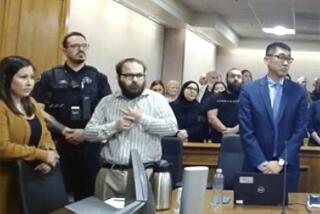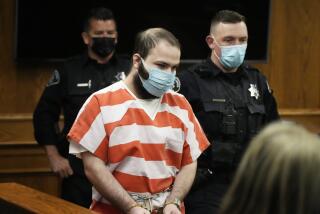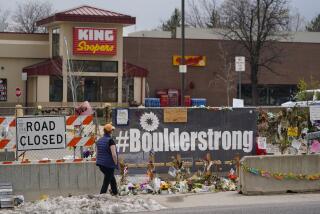23 Shot Dead at Texas Cafeteria : Massacre: A gunman drives his pickup through a window and opens fire with a semiautomatic handgun, in nation’s worst mass shooting. He is among the dead.
KILLEEN, Tex. — In the deadliest shooting spree in U.S. history, a man crashed his pickup truck into a cafeteria crowded with lunchtime patrons here Wednesday afternoon and began firing rapidly and indiscriminately with a semiautomatic pistol, killing 22 people.
The gunman later was found dead of a gunshot wound in a restaurant restroom, police said.
The massacre resulted in injuries to 20 others, many of them listed in “very critical condition.” The death toll passed by one the number killed by an out-of-work security guard in a McDonald’s restaurant in San Ysidro, Calif., seven years ago.
The assailant, a curly-haired man who was wearing dark sunglasses, was identified by authorities as George Jo Hennard, 35, of nearby Belton, Tex. It was not immediately clear whether he was shot by police or if he killed himself or if he was wounded and then committed suicide.
Killeen police late Wednesday merely issued a terse statement, noting that several officers were engaged in a gun battle with Hennard after they “cornered” the man. “Several rounds were fired by the suspect and were returned by the officers,” the statement said. “Mr. Hennard is deceased.”
John Marr, an assistant manager, told The Times that he was advised by a Texas state trooper that police shot the gunman in the stomach and that he then turned his own gun on himself.
Officials said Hennard was armed with a 9-millimeter Glock 17, described as a lightweight, Austrian-made handgun now in use by many federal, state and local law enforcement agencies. Marr said a second weapon, described as an empty Luger with the clip out and the firing chamber pulled back, was found on a tray on the serving line.
An autopsy on Hennard’s body is scheduled for today at Parkland Hospital in Dallas, and police said they hoped that they would then be able to tell exactly how he died.
Some witnesses said Hennard fired up to 100 rounds inside the cafeteria, and Killeen Police Chief F. L. Giacomozzi said that “he wasn’t out of bullets when the officers got there.”
Officials said the gunman smashed his blue truck through the eight-foot-high, plate-glass front window of Luby’s cafeteria, a red-brick, low-slung building just off the highway through this Central Texas town. At the time, the restaurant was unusually crowded with about 150 patrons and employees, including teachers and other workers treating their supervisors to lunch for national Boss’s Day.
Sheldon Smith, a cafeteria porter, said the man yelled: “This is what Bell County has done to me!” Another witness heard him swear: “I hope all this is worth it, Texas!”
Vicki Large, a 19-year-old pregnant employee, said that “he was mad,” but Giacomozzi, pressed to explain the man’s motive, said he knew of “none, whatsoever.”
Giacomozzi said the gunman killed 14 women and eight men. None of the dead were employees of the cafeteria.
Witnesses said the gunman’s first victim was a man who was shot after he was stuck under the truck. They said the gunman then systematically opened fire throughout the lunchroom.
“As fast as he could pull the trigger, he was shooting people,” one witness said. “He was just shooting randomly.”
He next headed toward the counter line, and for the next 10 minutes, witnesses said, the gunman would stop firing only long enough to reload. “He had tons of ammo,” Sam Wink, another customer, told Cable News Network. “He looked at me and pointed the pistol. I thought I’d bought the farm.”
Large, who is expecting her first child in April, saw the truck crash through the window from her vantage point behind the counter, where she was handling the breads and pies.
She said the man started shooting in the air while he was still in the driver’s seat of the truck. “I was directly looking at the man,” she said. “There he was, just shooting everywhere. When I saw him look at me, I turned around and ran.
“He had a lot of people to shoot because there were a lot of people in there . . . . I was lucky he didn’t shoot me.”
She ran with 20 back-room employees through the kitchen to a locked set of double doors at the back of the cafeteria. The assistant manager, Marr, rushed over to open the doors. She said Marr “ran back there when we ran back there, and he unlocked it for us and we all ran out. We were all bunched up and all fled in different directions. We were bunched up on my manager (while he unlocked the doors). I’m so glad he hurried up.”
Marr, in a telephone interview with The Times, said that his boss, associate manager Mark Copenhofer, told him that during the shooting, the gunman approached victims and asked: “Is it worth it?” or “Was it worth it?” Then he shot them.
Marr said Copenhofer also told him that the gunman told a woman with a child: “You have a child! Run!” The woman ran out with her child, and the gunman then shot the woman next to her, Marr said Copenhofer told him.
As of 10 hours after the shooting, another employee, described as an 18- or 19-year old male who graduated from high school last spring, was missing. The youth was not on the list of those killed or injured, Marr said, but he also had not called home or turned up at the hotel next door where employees and witnesses gathered.
“For all we know, he could be traumatized,” Marr said. “I don’t know what to think. I really don’t.”
Had anyone seen the gunman before? “The police officers were wondering the same thing,” Marr said. “To our knowledge, neither myself, Mr. Copenhofer nor Mr. (Robert) Butler, the store manager, had seen him before.”
Among those trapped inside the cafeteria, some desperately huddled under the furniture, hoping to escape the barrage. “I feel sorry for the people who fell on the floor and tried to hide under tables,” said David Alejandro, 22. “I think they were the ones who got it.”
Alejandro was eating steak and mashed potatoes when the truck smashed into the cafeteria. A soldier quickly broke a window, and Alejandro joined several patrons running that way. “My heart was beating,” he said, unable to fully describe the gunman. “All I could see was a hand and a gun.”
Eddie Sanchez, 31, had just brought his pregnant girlfriend, Angela Wilson, 24, to the cafeteria, where she works as a baker, when he saw the man “drive erratically and then crash into Luby’s.”
Frightened for Wilson, Sanchez said he ran inside just as two victims were shot. “I kept hollering for Angie,” he said. As the couple screamed each other’s names, the gunman heard her and turned. Sanchez said he screamed louder, to divert the man’s attention, and she dropped to the ground.
“He was taking his time and aiming,” Sanchez said, and the couple safely made it outside.
As others pushed for the exits, 74-year-old Odene Huron said she was caught up in the “cattle stampede.”
“I was pushed to the floor when I was trying to get out,” she said afterward, with her left ear cut. “And then I was trampled on. I started crawling out on my hands and knees to get out. Nobody helped me.”
The Hi-Lo auto parts store next door was suddenly filled with frantic people screaming for help. “One guy came in here. He said: ‘Give me a gun. I’ll go shoot him,’ ” said Robert Holland, a 26-year-old auto parts clerk. “We had people in here saying: ‘Call the cops!’ There were cops everywhere.”
The shooting occurred at 12:41 p.m. here and sent area law enforcement officers from several agencies scrambling to the scene. “But today was not a good day for him to do this,” said a Bell County Sheriff’s Department dispatcher. “We had everybody at the range, taking target practice.”
The owners of the Leon Heights market, about a half-block from Hennard’s home in Belton, described him as a “mean-spirited loner.” They recalled incidents in which he once shoved a customer at the cash register, spit on a van and flashed $100 bills and $100 travelers checks.
Mary Mead said Hennard showed up at the market Wednesday morning and put some groceries on his tab. “He said he’d be back in the afternoon to pay for it,” she said. “He seemed like he was in a nicer mood than normal.”
But her son, Jimmy Mead, said: “We were kind of scared of him. He was actually pretty rude. I was about to tell him not to come in here anymore.”
Mary Mead said that a few months ago, he walked in and “said he wanted me to tell everyone that, if they don’t stop messing around with his house, something bad is going to happen. I was so scared I didn’t know what to tell him.”
A neighbor near the Hennard home, a large antebellum-style mansion, said he had frightened her and her daughters for the past five months with bizarre behavior that included a rambling letter, phone calls and running in front of their cars. “We just lived in fear of the man,” said Jane Bugg, 46, a medical secretary.
Bugg said Hennard sent a letter to her daughters, Jana Jernigan, 19, and Jill Fritz, 23, last June that asked if they had found new boyfriends and read in part: “Please give me the satisfaction of someday laughing in the face of all those mostly white, treacherous female vipers from two towns who tried to destroy me and my family.”
After the carnage ended, the wounded and shocked survivors sat comforting each other and shaking on the pavement outside.
Authorities began removing the bodies about 9 p.m. About 20 plainclothes officers formed a human corridor as the bodies were placed inside a group of white hearses. Flags around town were lowered to half-staff.
Police released the names of eight fatalities--Zona Hunnicut Lynn, Clodine Humphrey, Olgica Andonovska Taylor, Thomas Earl Simmons, Ruth Pujol, Nancy Hedgepeth Stansbury, Juanita C. Williams, and Pat Carney.
One Luby’s employee, Maria Serna, 41, was treated for hypothermia after she hid in a restaurant freezer for 2 1/2 hours, unaware that it was safe to come out, Metroplex Hospital spokesman Ricky Seiler said.
Luby’s, on a frontage road along U.S. 190, which cuts through Killeen, is one of the most popular restaurants in the city of about 50,000 people.
Buddy Schrader, vice president of marketing for Luby’s, told Associated Press that the company has set aside 50 motel rooms for victims’ relatives.
In addition, the company and the Red Cross will provide counselors to victims, relatives and employees.
Bell County surrounds Killeen, which is about 60 miles north of the state capital, Austin. It is the largest of four towns that rim Ft. Hood, home to two tank divisions on land that straddles three Texas counties. Nearly 100,000 people live on the post or in the immediate area, and about 23,000 of them served in the Persian Gulf War earlier this year--the largest contingent from Texas.
The Killeen Chamber of Commerce sells the community on low taxes, an affordable cost of living and excellent schools. Downtown Killeen is a collection of surplus stores, pawnshops and retail outlets, many operated by Korean-Americans whose families moved in after the Korean War.
The safety of the Glock pistol used by Hennard has been questioned in the past by the FBI, which has characterized it as having a “high potential for unintentional shots.”
Karl Walter, vice president of Glock Inc.’s North American headquarters in Smyrna, Ga., said he was very upset about the tragedy in Killeen.
“I support anything to keep such tragedies from happening,” he said. “I’m distressed these events have occurred.”
He said he recently met with Sarah Brady, whose husband, former White House Press Secretary James S. Brady, has pushed for tighter gun control laws since he was severely wounded during an attempted assassination of former President Ronald Reagan. Walter also said he has talked with law enforcement officials on finding ways “to keep firearms from falling into the hands of deranged people or criminals.”
Sarah Brady was in Washington on Wednesday, pushing an omnibus Anti-Crime Bill that contains a ban on gun clips that carry more than seven rounds.
“Does the U.S. House need a clearer message before it musters the courage to stand up to the gun lobby?” she said. “Tomorrow, the whole world will be watching.”
Of the 18 worst mass killers in the United States, all but four have struck since 1982.
Until Wednesday, the worst gun massacre was in July, 1984, when James Oliver Huberty burst into a McDonald’s restaurant and killed 21 people before he was fatally shot.
Another mass slaying occurred in nearby Austin, where Charles Whitman, a student, shot and killed 16 people from a campus tower at the University of Texas in 1966.
The worst mass slaying in U.S. history occurred March 25, 1990, when a man named Julio Gonzalez set fire to a social club in New York’s Bronx section, killing 87 people. Gonzalez was convicted of 174 counts of murder--two categories of murder for each victim--and was sentenced to 25 years to life in prison.
Hart reported from Killeen and Wood from Los Angeles. Also contributing to this story were Times staff writers J. Michael Kennedy in Killeen and Richard A. Serrano in Los Angeles.
BACKGROUND
The Glock 9-millimeter semiautomatic pistol, the weapon Texas authorities say a gunman used to kill 22 people, is of simple design. Most of the Austrian-manufactured pistol is made of a polymer material, contributing to its light weight. The standard Model 17 is fed by a 17-round magazine. It is 7 inches long and weighs just two pounds fully loaded. Another model, the Glock 18, can be switched to fully automatic fire and can carry a magazine of up to 33 rounds. Tens of thousands of the Model 17 guns are in use by U.S. police departments. Military and police forces in at least 41 other countries also are armed with the Model 17.
More to Read
Sign up for Essential California
The most important California stories and recommendations in your inbox every morning.
You may occasionally receive promotional content from the Los Angeles Times.










